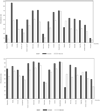Cohabitation, gender, and alcohol consumption in 19 countries: a multilevel analysis
- PMID: 20397870
- PMCID: PMC3076585
- DOI: 10.3109/10826081003692106
Cohabitation, gender, and alcohol consumption in 19 countries: a multilevel analysis
Abstract
We used an ecological paradigm and multilevel analytic techniques to analyze gender-specific relationships of cohabitation (versus marriage) to drinking in 19 countries (n = 32,922) and to "heavy episodic drinking" (HED) in 17 countries (n = 24,525) in surveys (1996-2004) from Gender, Alcohol, and Culture: An International Study. Cohabitation was associated with elevated risk of HED among drinkers of both genders, controlling for age, education, and societal characteristics. The association between cohabitation and HED tended to be stronger for female drinkers than for male drinkers. HED was more prevalent among younger drinkers, especially among younger women in countries with higher per capita gross domestic product. Cross-culturally, cohabiters deserve special attention in prevention efforts for hazardous drinking, considering both individual-level and societal factors.
Conflict of interest statement
The authors report no conflicts of interest. The authors alone are responsible for the content and writing of the paper.
Figures


Similar articles
-
Alcohol use, heavy episodic drinking and subsequent problems among adolescents in 23 European countries: does the prevention paradox apply?Addiction. 2012 Jan;107(1):71-80. doi: 10.1111/j.1360-0443.2011.03537.x. Epub 2011 Sep 21. Addiction. 2012. PMID: 21672071
-
Prevalence and determinants of heavy episodic drinking among adults in Kenya: analysis of the STEPwise survey, 2015.BMC Public Health. 2018 Nov 7;18(Suppl 3):1216. doi: 10.1186/s12889-018-6057-6. BMC Public Health. 2018. PMID: 30400910 Free PMC article.
-
High-Intensity Drinking Versus Heavy Episodic Drinking: Prevalence Rates and Relative Odds of Alcohol Use Disorder Across Adulthood.Alcohol Clin Exp Res. 2017 Oct;41(10):1754-1759. doi: 10.1111/acer.13475. Epub 2017 Sep 5. Alcohol Clin Exp Res. 2017. PMID: 28800154 Free PMC article.
-
The country-level effects of drinking, heavy drinking and drink prices on pre-drinking: An international comparison of 25 countries.Drug Alcohol Rev. 2017 Nov;36(6):742-750. doi: 10.1111/dar.12525. Epub 2017 Mar 13. Drug Alcohol Rev. 2017. PMID: 28295899
-
Sociodemographics, lifestyle factors and health status indicators associated with alcohol consumption and related behaviours: a Brazilian population-based analysis.Public Health. 2020 Jan;178:49-61. doi: 10.1016/j.puhe.2019.08.011. Epub 2019 Oct 12. Public Health. 2020. PMID: 31614326
Cited by
-
Cohabitation and mental health: Is psychotropic medication use more common in cohabitation than marriage?SSM Popul Health. 2018 Feb 2;4:244-253. doi: 10.1016/j.ssmph.2018.01.001. eCollection 2018 Apr. SSM Popul Health. 2018. PMID: 29854908 Free PMC article.
-
Systematic review and meta-analysis: prevalence of alcohol use among young people in eastern Africa.Trop Med Int Health. 2014 Apr;19(4):476-88. doi: 10.1111/tmi.12267. Epub 2014 Jan 31. Trop Med Int Health. 2014. PMID: 24479379 Free PMC article.
-
Predictors of premarital cohabitation timing among young women in Ethiopia: insights from the 2016 demographic and health survey using a shared frailty model.Front Glob Womens Health. 2024 Oct 3;5:1327219. doi: 10.3389/fgwh.2024.1327219. eCollection 2024. Front Glob Womens Health. 2024. PMID: 39421699 Free PMC article.
-
The Cross-Cultural Association Between Marital Status and Physical Aggression Between Intimate Partners.J Fam Violence. 2013 May 1;28(4):403-418. doi: 10.1007/s10896-013-9505-1. J Fam Violence. 2013. PMID: 24039342 Free PMC article.
-
Predictors of Postpartum Change in Alcohol Use in Norwegian Mothers.J Stud Alcohol Drugs. 2015 Jul;76(4):559-68. doi: 10.15288/jsad.2015.76.559. J Stud Alcohol Drugs. 2015. PMID: 26098031 Free PMC article.
References
-
- Ahlstrom S, Bloomfield K, Knibbe R. Gender differences in drinking patterns in nine European countries: descriptive findings. Substance Abuse. 2001;22:69–85. - PubMed
-
- Bacharach S, Bamberger PA, Sonnenstuhl WJ, Vashdi D. Aging and drinking problems among mature adults: the moderating effects of positive alcohol expectancies and workforce disengagement. Journal of Studies on Alcohol Drugs. 2008;69(1):151–159. - PubMed
-
- Bachman JG, O’Malley PM, Johnston LD. Drug use among young adults: the impacts of role status and social environment. Journal of Personality and Social Psychology. 1984;47(3):629–645. - PubMed
-
- Bjarnason T, Andersson B, Choquet M, Elekes Z, Morgan M, Rapinett G. Alcohol culture, family structure and adolescent alcohol use: multilevel modeling of frequency of heavy drinking among 15–16 year old students in 11 European countries. Journal of Studies on Alcohol. 2003;64(2):200–208. - PubMed
-
- Bloomfield K, Gmel G, Wilsnack S. Introduction to special issue ‘gender, culture and alcohol problems: a multi-national study.’. Alcohol and Alcoholism Supplement. 2006;41(1):i3–i7. - PubMed
Publication types
MeSH terms
Grants and funding
LinkOut - more resources
Full Text Sources
Medical
